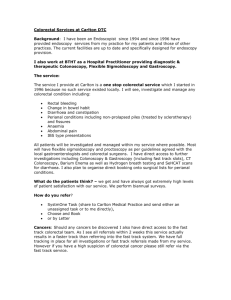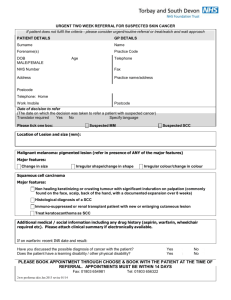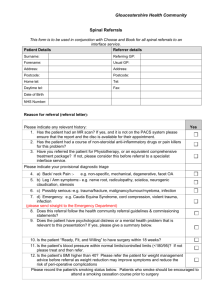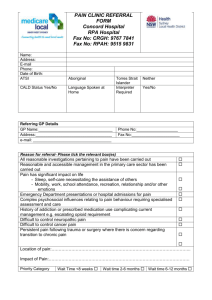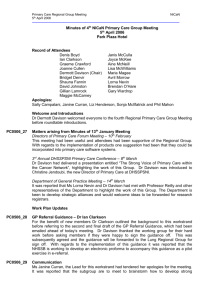Colorectal Cancer Pathway Sequences by Cancer Type
advertisement
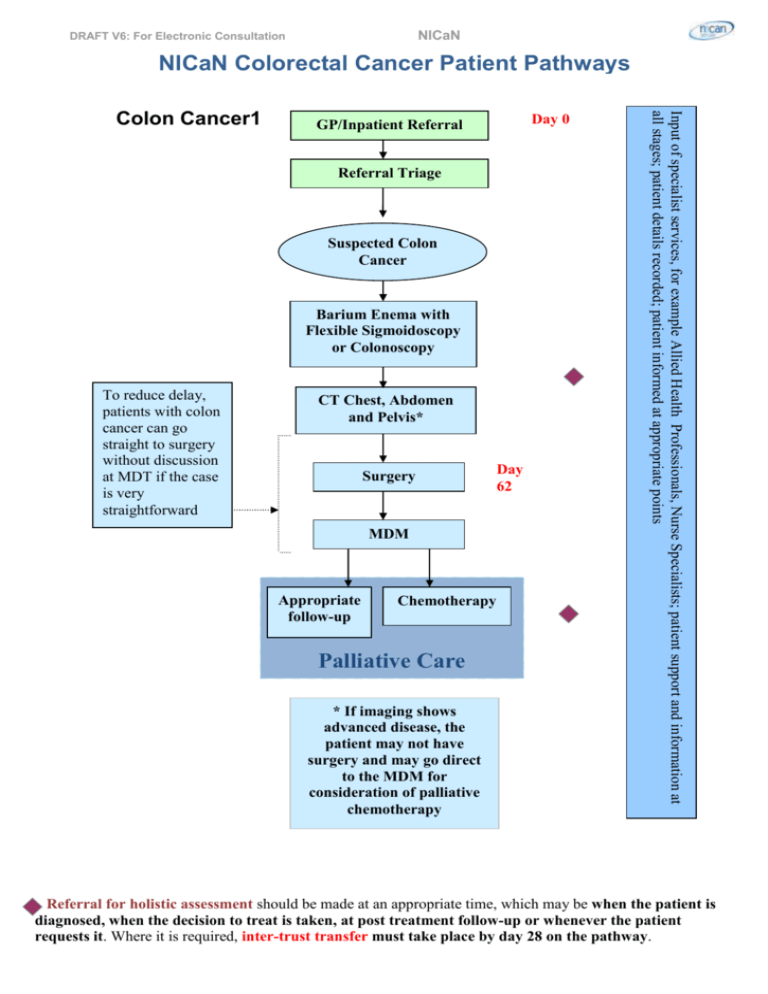
NICaN DRAFT V6: For Electronic Consultation NICaN Colorectal Cancer Patient Pathways Day 0 GP/Inpatient Referral Referral Triage Suspected Colon Cancer Barium Enema with Flexible Sigmoidoscopy or Colonoscopy To reduce delay, patients with colon cancer can go straight to surgery without discussion at MDT if the case is very straightforward CT Chest, Abdomen and Pelvis* Surgery MDM Appropriate follow-up Chemotherapy Palliative Care * If imaging shows advanced disease, the patient may not have surgery and may go direct to the MDM for consideration of palliative chemotherapy Day 62 Input of specialist services, for example Allied Health Professionals, Nurse Specialists; patient support and information at all stages; patient details recorded; patient informed at appropriate points Colon Cancer1 Referral for holistic assessment should be made at an appropriate time, which may be when the patient is diagnosed, when the decision to treat is taken, at post treatment follow-up or whenever the patient requests it. Where it is required, inter-trust transfer must take place by day 28 on the pathway. NICaN DRAFT V6: For Electronic Consultation GP/Inpatient Referral Day 0 Referral Triage Suspected Rectal Cancer Biopsy These two stages may be combined in CT Colonography Barium Enema or Colonoscopy CT Chest, Abdomen and Pelvis MRI pelvis and/or Endorectal Ultrasound MDM Pre-op radiotherapy (long or short course) Surgery Surgery MDM Appropriate follow-up Chemotherapy Day 62 Input of specialist services, for example Allied Health Professionals, Nurse Specialists; patient support and information at all stages; patient details recorded; patient informed at appropriate points Rectal Cancer Palliative Care Referral for holistic assessment should be made at an appropriate time, which may be when the patient is diagnosed, when the decision to treat is taken, at post treatment follow-up or whenever the patient requests it. Where it is required, inter-trust transfer must take place by day 28 on the pathway. NICaN DRAFT V6: For Electronic Consultation GP/Inpatient Referral Day 0 Referral Triage Suspected Anal Cancer Biopsy, usually under general anaesthetic CT Chest, Abdomen and Pelvis MRI (Optional) MDM Chemoradiation (Usually) Surgery (Local Excision) Salvage Surgery Appropriate follow-up Palliative Care Day 62 Input of specialist services, for example Allied Health Professionals, Nurse Specialists; patient support and information at all stages; patient details recorded; patient informed at appropriate points Anal Cancer Purpose of the pathway Referral for holistic assessment should be made at an appropriate time, which may be when the patient is diagnosed, when the decision to treat is taken, at post treatment follow-up or whenever the patient requests it. Where it is required, inter-trust transfer must take place by day 28 on the pathway. DRAFT V6: For Electronic Consultation NICaN This pathway has been developed by the NICaN Regional Colorectal Cancer Group to: Support quality service provision by outlining an evidence based patient pathway for those with colorectal cancers; Enable clinical, managerial and lay people to see an outline of what patients with colorectal cancer can expect across the patient pathway at different stages of the cancer journey; Enable key staff at all levels throughout Health and Social Care Services to identify where patients should be in their journey at a certain time point, to assist in monitoring performance against the cancer access standards (31/62 day targets). While this pathway is applicable in the majority of cases, the primary concern must always be to ensure that care is provided according to the wishes and needs of each patient. Service Optimisation There are a number of practical steps that could be taken to improve patients’ experience of care and reduce cancer waiting times. Such steps may include: Streamlining the referral route – one route, single queue, one point of contact Pooling referrals Straight to test Combining tests/visits Agreed protocols for diagnosis/staging Robust booking/scheduling systems Competency based workforce development with skill mix and extended roles The Belfry Plan provides a pragmatic evidence-based approach to improving the quality and timeliness of care for patients with gastrointestinal problems due to cancer and other conditions. 2007/2008 PFA Cancer Access Standards 98% of patients diagnosed with cancer (decision to treat) should begin their treatment within a maximum of 31 days 75% of patients urgently referred with a suspected cancer should begin their first definitive treatment within a maximum of 62 days. Where the performance of a tumour group currently exceeds this standard, performance should be sustained or improved against current levels Timed Schedule ‘Day 0’ and ‘Day 62’ on the pathway mark the stage of the pathway the patient should have reached by this stage in their journey and are included to support the proactive management of the patient from point of receipt of referral to first definitive treatment. It is recognised that there may be different service pressures in each Trust. Clinical Teams working with Executive Leads should resolve these internally to ensure the Cancer Access Standards (above) are met. Continued… Management of referrals Referral for holistic assessment should be made at an appropriate time, which may be when the patient is diagnosed, when the decision to treat is taken, at post treatment follow-up or whenever the patient requests it. Where it is required, inter-trust transfer must take place by day 28 on the pathway. DRAFT V6: For Electronic Consultation NICaN Consideration needs to be given to the management of the symptomatic patient referred, but not suspected of, having cancer. ‘Red Flag’ referrals for patients suspected of having cancer should meet the guidelines set out in the NICaN guidelines for the referral of suspected cancer (2007). Referrals which do not meet these guidelines may be downgraded by the consultant if agreement is reached with the referring GP. Selecting a diagnostic test The NHS document ‘Improving Endoscopy Services – meeting the challenges’ (National Endoscopy Team for ACPGBI Conference 2006) acknowledges the role of colorectal surgeons in supporting developments in colonoscopy. The Association of Coloproctology of Great Britain and Northern Ireland, in its Guidelines for the management of colorectal cancer (2007), recommends that Patients referred with suspected colorectal cancers should be investigated with sigmoidoscopy (flexible or rigid) plus a high quality double contrast barium enema, or colonoscopy, or CT colonography. The British Society of Gastroenterology published guidelines in GUT “Guidelines for colorectal cancer screening and surveillance in high risk groups” [Gut 2002; 51 (Suppl V):v28] and in most cases colonoscopy is the recommended diagnostic test. The selected method of investigation is dependent upon clinical judgement based on patient need and available service capacity. Evidence and Rationale The evidence base and rationale for this document is set out in the following documents: Manual of Cancer Services Standards, Colorectal Cancer Update July 2004, DH (http://www.dh.gov.uk/en/Publicationsandstatistics/Lettersandcirculars/Dearcolleagueletters/ DH_4090080) Association of Coloproctology of Great Britain and Ireland Guidelines 2007 (http://www.acpgbi.org.uk/documents/COLO%20guides.pdf) Improving Outcomes in Colorectal Cancers – Manual Update NICE 2004 (http://www.nice.org.uk/nicemedia/pdf/CSGCCfullguidance.pdf) Improving Supportive and Palliative Care for Adults with Cancer: The Manual NICE 2004 (http://www.nice.org.uk/nicemedia/pdf/csgspmanual.pdf) Guidelines for colorectal cancer screening and surveillance in high risk groups, BSG in GUT.BMJ 2002; 51 (Suppl V):28 (http://gut.bmj.com/cgi/reprint/51/suppl_5/v28.pdf) Holistic Common Assessment of Supportive and Palliative Care Needs for Adults with Cancer, Kings College London, January 2007 (http://www.dh.gov.uk/en/Publicationsandstatistics/Publications/PublicationsPolicyAndGuida nce/DH_076928) Priorities for Action 2007-08, DHSSPS, 2007 (http://www.dhsspsni.gov.uk/pfa_2007-08.pdf) The Belfry Plan, Cancer Services Collaborative, 2005 (http://www.cancerimprovement.nhs.uk/%5Cdocuments%5Cbowel%5CBelfry_Plan.pdf) Improving Endoscopy Services – meeting the challenges’ (National Endoscopy Team for ACPGBI Conference, 2006) (http://www.endoscopy.nhs.uk/%5Cresources%5Cpublications%5CNHS_MTC.pdf) Referral Guidance for Suspected Cancer (NICaN 2007) (www.nican.n-i.nhs.uk) Referral for holistic assessment should be made at an appropriate time, which may be when the patient is diagnosed, when the decision to treat is taken, at post treatment follow-up or whenever the patient requests it. Where it is required, inter-trust transfer must take place by day 28 on the pathway.
